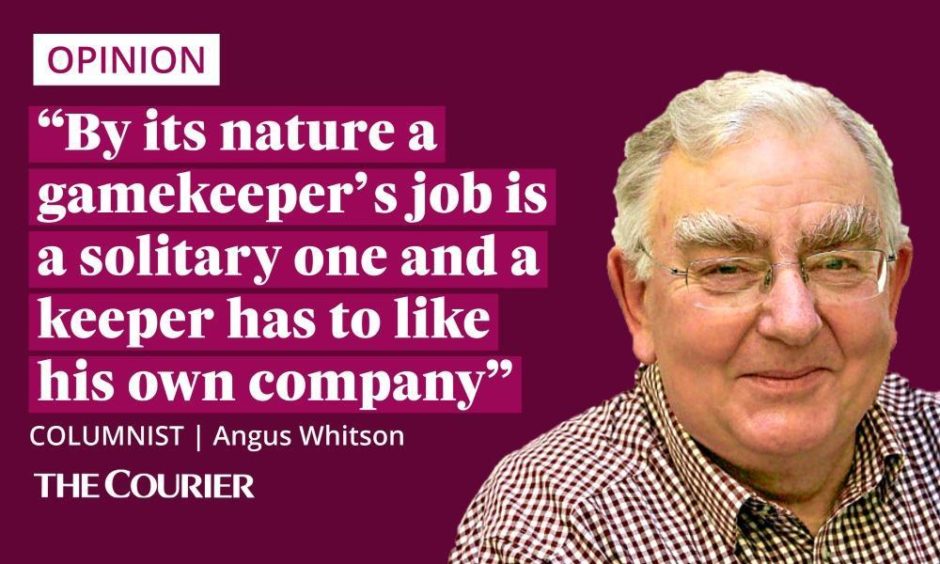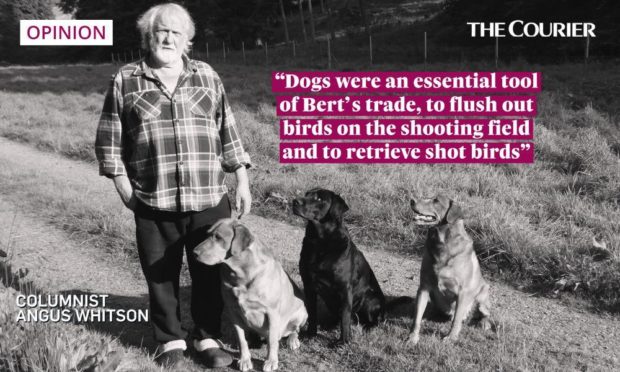Bert Burnett, retired gamekeeper, opened his front door and three noisy Labradors – Buck, Bru and Dude – burst out in a great broadside of barking.
But I’d seen it all before – all talk and no trousers.
When they realised I wasn’t quivering with fright it all changed. Tails swishing apologetically they became quite embarrassed – dogs do experience embarrassment, you know.
“So sorry”, they seemed to be saying. “We thought you were someone else”.
Then they smelled Inka on my clothing and my trouser legs had to be sniffed all over.

When dogs have been part of your life, all of your life, retired gamekeepers just can’t get out of the habit of having at least one at their heel.
Bert still goes picking up at shoots and his three dogs are his team.
Bert has been retired for 10 years but I was interested to learn how much life and work for gamekeeper had changed over the years of his working life.
After leaving school he was employed in a linoleum factory.
It was not his idea of a job and he advertised for work in the local newspaper.
He started his keepering in 1964 as a 15 year-old trainee underkeeper on the Fotheringham estate outside Forfar.
He learned his trade there and how to look after himself too, living on his own in a bothy, doing his own washing and cleaning and cooking.
When he married he moved to an estate near Edzell as a single-handed keeper looking after some 6,000 acres.
Less a job than a way of life
Keepering is a vocation.
By its nature a gamekeeper’s job is a solitary one and a keeper has to like his own company.
He must not mind getting out of bed at 6am on a Monday knowing he has to dig a ditch that day regardless of the weather, or fix fences, sort butts or repair roads.
As often as not Bert took a spade to work rather than a gun.
“There are many gamekeepers & deer stalkers employed on estates across Cairngorms National Park helping to conserve & enhance landscapes, benefiting a wide range of habitats & species.” @ScotGamekeepers @ADMGScotland @BASCScotland https://t.co/Pkweox7msH
— Doug McAdam (@DougMcAdam) August 27, 2021
As indispensable as any of his practical keepering skills, Bert learned to be a diplomat, a people person – how to deal with what he called the gossip chain.
Eight guests shooting with Bert one week might be shooting on eight other estates a week later.
Word could quickly spread if he was not seen to be doing things right, to his own and the estate’s detriment.
The right to roam giving everyone statutory rights of access over land throughout Scotland further honed his diplomacy skills.
Changed days for gamekeepers
When Bert started his keepering there was no commercial raising of game birds as estate shoots were run for the benefit of the laird and his friends.
But the effects of the Second World War were still being felt – sons and heirs had died in the war and there was no one to inherit and estates were broken up and sold.
It became harder to run estates profitably and commercial shooting provided a solution.
Estates began offering shooting days to syndicates with a number of days reserved for the laird and his family.
Estates began to be seen strictly as investments and were bought up by hedge fund managers for whom profit was the endgame.
As game shooting became more popular more birds were reared, and pressure increased on gamekeepers to run their shoots profitably.
The shooting experience on some estates was developed to provide lavish lunches with fine wines in the Big Hoose – all at a cost, of course.
Every day had its dog
But it wasn’t all hard graft and no pleasure.
Dogs were an essential tool of Bert’s trade, to flush out birds on the shooting field and to retrieve shot birds.
He could not have carried out his job without them.
He used springer spaniels for general work such as rabbiting, and Labradors for field trialling.
Field trials test the working ability of gundogs under competitive conditions replicating as closely as possible the working conditions a dog might encounter during a day’s shooting in the field.
It isn’t just the dog that is being tested.
It’s a partnership between dog and handler and the handler’s ability to train his dog and direct it in the field are tested too.
In a successful career Bert won trials and was placed in many competitions.
Changed days for gamekeepers – and few regrets
The gamekeeper’s job suited Bert.
A tied house went with the job, an estate vehicle went with the job, the wages were comparable with factory wages and he was largely his own boss.
But he was on call 24/7 and when I asked about holidays he smiled and said his job was his holiday.
I came away thinking that the fundamentals of the job for gamekeepers have remained much the same but the introduction of health and safety and wildlife welfare and protection legislation have introduced a layer of administrative bureaucracy.
When I got home Inka bounded out to greet me.
He smelled Buck, Bru and Dude on my clothing and my trouser legs had to be sniffed all over again.
